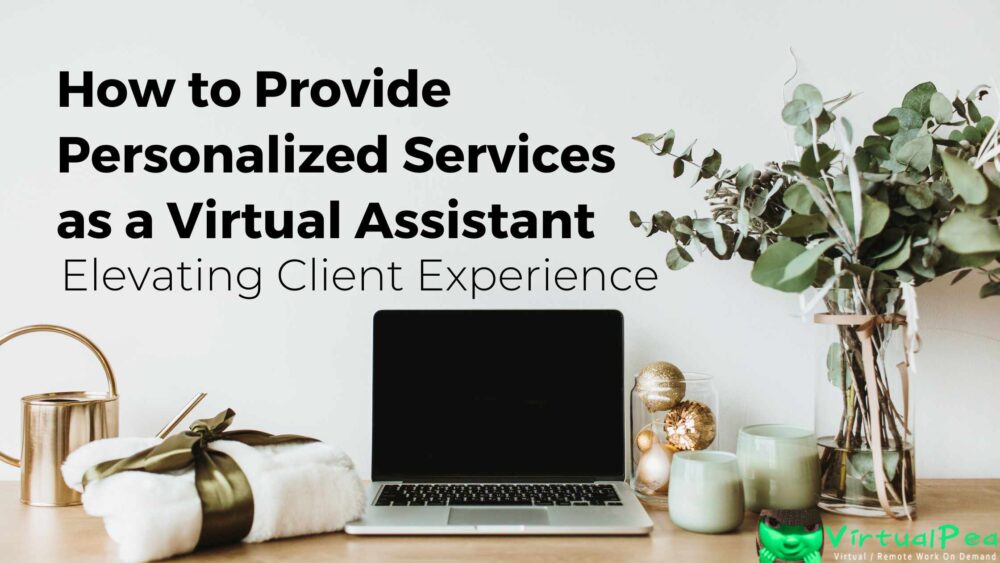
As a virtual assistant, offering personalized services is key to standing out in a competitive market and ensuring client satisfaction. Personalization goes beyond providing generic support and involves tailoring your approach to meet each client’s unique needs and preferences. In this article, we will explore effective strategies for providing personalized services as a virtual assistant, enabling you to deliver customized solutions and elevate the client experience.
1. Understand Your Client’s Goals and Expectations
To provide personalized services, it’s crucial to have a deep understanding of your client’s goals, expectations, and pain points. Take the time to communicate with your client, ask thoughtful questions, and actively listen to their needs. This insight will help you align your services and deliver tailored solutions that meet their specific objectives.
2. Customize Your Approach
Tailor your approach to match each client’s preferences and working style. Adapt your communication methods, collaboration tools, and project management processes to suit their specific requirements. By adjusting your approach, you demonstrate your flexibility and commitment to providing a personalized experience.
3. Offer a Range of Services
Expand your skill set and service offerings to provide clients with a comprehensive range of options. By diversifying your expertise, you can cater to different client needs and offer specialized services in various areas. This flexibility allows you to meet the specific demands of each client and provide a personalized service package.

4. Regularly Seek Feedback
Feedback is invaluable for improving your services and tailoring them to your client’s satisfaction. Regularly request feedback from clients to understand their experiences, identify areas for improvement, and address any concerns. Actively implementing client feedback demonstrates your commitment to delivering personalized and client-centric services.
5. Stay Up-to-Date with Industry Trends
To provide personalized services, it’s essential to stay informed about the latest trends and developments in your industry. By staying up-to-date, you can offer clients innovative solutions and insights that align with current industry best practices. This proactive approach showcases your expertise and enhances the value you bring to clients.
6. Develop Strong Relationships
Building strong relationships with clients is fundamental to delivering personalized services. Invest time in fostering meaningful connections, maintaining open lines of communication, and demonstrating your dedication to their success. By developing strong relationships, you can better understand their evolving needs and consistently provide personalized support.
Providing personalized services as a virtual assistant is essential for differentiating yourself in the market and ensuring client satisfaction. By understanding your client’s goals, customizing your approach, offering a range of services, seeking feedback, staying up-to-date with industry trends, and developing strong relationships, you can deliver tailored solutions and elevate the client experience. Implement these strategies to provide exceptional personalized services and cultivate long-lasting client partnerships.

As a virtual assistant, one of your key responsibilities may involve creating engaging content for your clients. Whether it’s blog posts, social media updates, newsletters, or website copy, the quality and effectiveness of your content can greatly impact your clients’ online presence. In this comprehensive guide, we will share valuable tips and techniques to help you create compelling and engaging content as a virtual assistant.
1. Understand Your Client’s Brand and Target Audience
Before creating content, it’s essential to understand your client’s brand identity and target audience. Familiarize yourself with their brand voice, values, and messaging. This knowledge will guide your content creation process and help you create content that resonates with the target audience.
2. Research and Stay Updated on Industry Trends
Stay up-to-date with the latest industry trends and developments in your client’s niche. Conduct thorough research to understand the topics, keywords, and formats that are popular and relevant to the target audience. This will enable you to create content that is timely and valuable.
3. Develop a Content Strategy
Create a content strategy that aligns with your client’s goals and objectives. This involves planning the types of content to create, the platforms to publish on, and the frequency of posting. A well-defined content strategy ensures consistency and helps you deliver content that supports your client’s overall marketing efforts.
4. Write Compelling Headlines and Introductions
Craft attention-grabbing headlines and introductions to captivate your audience from the start. Use strong and compelling language, pose intriguing questions, or highlight the benefits of reading the content. A compelling headline and introduction will entice readers to continue reading.

5. Incorporate Visual Elements
Engage your audience visually by incorporating relevant and eye-catching visuals in your content. This includes images, infographics, videos, or charts that enhance the readability and appeal of the content. Visual elements help break up text and make the content more engaging.
6. Tell Stories and Use Personal Examples
Storytelling is a powerful technique to captivate readers and make your content relatable. Incorporate anecdotes, personal examples, or case studies to illustrate your points and connect with the audience on a deeper level. Stories create an emotional connection and keep readers engaged.
7. Use a Conversational Tone
Write in a conversational tone to make your content more approachable and relatable. Avoid using jargon or complex language that might alienate readers. Instead, aim for clarity, simplicity, and a friendly tone that resonates with your audience.
8. Incorporate Call-to-Actions (CTAs)
Include clear and compelling call-to-actions in your content to guide readers towards the desired action. Whether it’s subscribing to a newsletter, sharing the content, or making a purchase, CTAs prompt readers to take the next step and engage further with your client’s brand.
Creating engaging content as a virtual assistant is an important skill that can elevate your clients’ online presence and drive results. By understanding your client’s brand, staying updated on industry trends, developing a content strategy, and incorporating writing techniques such as compelling headlines, storytelling, and visual elements, you can create content that captivates your audience and achieves the desired outcomes.
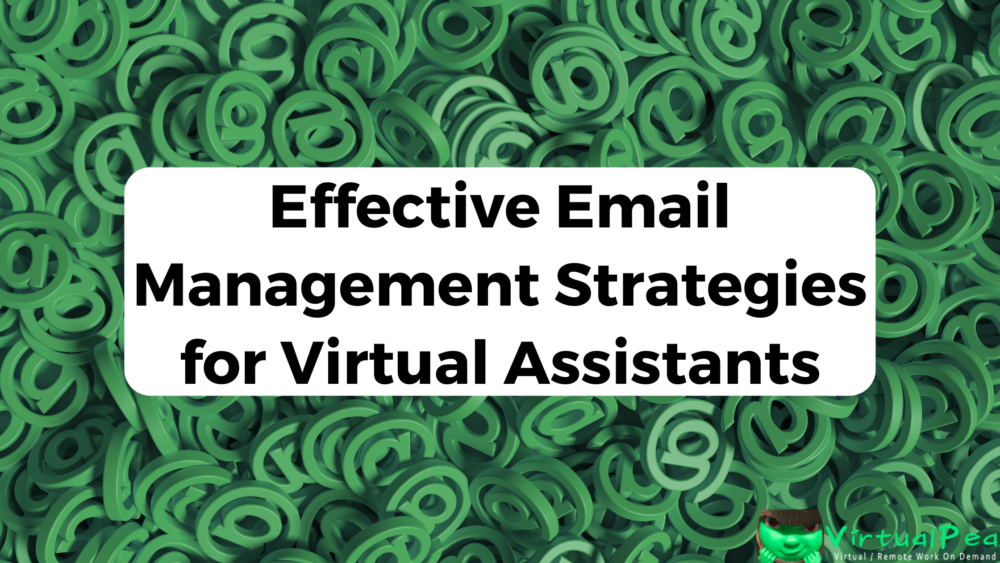
As a virtual assistant, managing email efficiently is essential for maintaining effective communication with clients and optimizing productivity. With the constant influx of messages, it’s crucial to implement effective email management strategies. In this article, we will explore practical tips and techniques for virtual assistants to manage their emails effectively. From inbox organization to email filtering and the use of email templates, these strategies will help you stay organized, save time, and enhance client communication.
1. Inbox Organization
Start by organizing your inbox into specific folders or categories to easily locate and manage emails. Create folders based on clients, projects, or priority levels. Develop a filing system that works best for you and consistently move emails to their respective folders after processing them. A well-organized inbox ensures that important emails don’t get buried and allows for efficient retrieval when needed.
2. Email Filtering and Rules
Utilize email filtering and rules to automate the organization and management of your emails. Set up filters to automatically sort incoming messages into relevant folders based on criteria such as sender, subject, or keywords. This saves time and ensures that important emails are prioritized. Regularly review and adjust filters as needed to maintain accuracy and effectiveness.

3. Effective Email Prioritization
Prioritize your emails based on urgency and importance. Start by scanning your inbox and identifying emails that require immediate attention or have strict deadlines. Utilize features such as flags or stars to mark important emails for quick reference. Develop a system for categorizing emails based on their priority level to ensure you address critical matters promptly and efficiently.
4. Use Email Templates
Create and utilize email templates for common inquiries, responses, or client communications. Templates can save you time and ensure consistency in your email communication. Customize the templates as needed to personalize the message for each client or situation. By using templates, you can streamline your responses and handle repetitive email tasks more efficiently.
5. Regular Email Maintenance
Schedule dedicated time for email management to avoid becoming overwhelmed. Set aside specific periods throughout the day to process and respond to emails. Avoid constantly checking your inbox, as it can lead to distractions and hinder productivity. Instead, establish a routine that allows you to focus on other tasks and allocate specific time slots for email management.
Effective email management is essential for virtual assistants to maintain clear communication, save time, and optimize productivity. By implementing strategies such as inbox organization, email filtering, effective email prioritization, the use of email templates, and regular email maintenance, virtual assistants can stay organized, enhance client communication, and effectively manage their email workload. Incorporate these practices into your daily routine to streamline your email management process and improve your overall efficiency as a virtual assistant.

As a virtual assistant, effective project management is crucial for delivering outstanding results to clients and ensuring the success of your virtual team. Remote project management requires efficient communication, meticulous planning, and strong organizational skills. In this article, we will explore essential tips for remote project management as a virtual assistant, enabling you to optimize productivity, streamline workflows, and foster seamless collaboration within virtual teams.
1. Establish Clear Project Goals and Objectives
Before diving into a project, it’s essential to establish clear goals and objectives. Collaborate with your client or team to define the desired outcomes, project scope, and key deliverables. This clarity ensures that everyone is aligned and working towards the same objectives, facilitating smoother project execution.
2. Utilize Project Management Tools
Leverage project management tools to streamline workflows, manage tasks, and enhance collaboration. Tools such as Asana, Trello, or Monday.com provide a centralized platform for tracking progress, assigning tasks, setting deadlines, and communicating with team members. These tools promote transparency, accountability, and efficient project management.
3. Define Roles and Responsibilities
Clearly define roles and responsibilities for each team member involved in the project. Establishing who is responsible for specific tasks and deliverables eliminates confusion and ensures accountability. Clearly communicate these roles and expectations to avoid duplication of efforts and ensure efficient project execution.

4. Foster Effective Communication
Communication is vital in remote project management. Establish regular check-ins and team meetings to provide project updates, address any concerns, and ensure everyone is on the same page. Utilize communication tools like Slack or Microsoft Teams to facilitate real-time communication, file sharing, and collaboration. Encourage open and transparent communication to maintain a strong virtual team dynamic.
5. Break Down Projects into Manageable Tasks
Break down projects into smaller, manageable tasks with clear deadlines. This approach helps prevent overwhelm and allows for better tracking and progress monitoring. Use task management tools to assign tasks, set priorities, and ensure timely completion of each task.
6. Set Realistic Deadlines and Milestones
Establish realistic deadlines and milestones for the project. Consider the complexity of tasks, available resources, and potential dependencies. Setting achievable timelines promotes efficiency, minimizes stress, and enables proper planning and allocation of resources.
7. Regularly Evaluate Progress and Adjust
Continuously evaluate project progress to identify any bottlenecks or areas for improvement. Regularly review the project’s status, milestones, and deliverables to ensure alignment with the overall project objectives. Adjust timelines or resources as needed to stay on track and address any challenges that arise.
Effective remote project management is vital for virtual assistants to deliver exceptional results and foster seamless collaboration within virtual teams. By establishing clear project goals, utilizing project management tools, defining roles and responsibilities, fostering effective communication, breaking down projects into manageable tasks, setting realistic deadlines, and regularly evaluating progress, you can optimize productivity and ensure project success. Implement these tips and elevate your remote project management skills as a virtual assistant.

As a virtual assistant, effective collaboration with your clients is crucial for a successful partnership. Fortunately, numerous remote collaboration tools are available to streamline communication, project management, and file sharing. In this article, we will explore essential remote collaboration tools for virtual assistants and clients. From communication platforms to project management and file sharing tools, these resources will optimize your workflow and enhance collaboration with clients in a virtual environment.
1. Communication Tools
Clear and efficient communication is the foundation of successful collaboration. Utilize communication tools that offer instant messaging, voice calls, and video conferencing capabilities. Popular options include Slack, Microsoft Teams, and Google Meet. These platforms allow real-time communication, facilitating quick discussions, updates, and problem-solving between virtual assistants and clients.
2. Project Management Platforms
Effectively managing tasks and projects is essential for virtual assistants. Project management platforms provide centralized spaces to create, assign, and track tasks, deadlines, and milestones. Tools like Trello, Asana, and Monday.com offer intuitive interfaces, collaboration features, and progress tracking capabilities. They enable virtual assistants and clients to stay organized, prioritize tasks, and monitor project progress in real-time.

3. File Sharing and Document Collaboration
Efficient sharing and collaboration on documents and files are crucial for virtual assistants and clients. Cloud-based storage solutions such as Google Drive, Dropbox, and OneDrive allow easy file sharing, version control, and simultaneous document editing. These tools ensure that all stakeholders have access to the latest files, fostering seamless collaboration and reducing versioning issues.
4. Time Tracking and Productivity Tools
Tracking time and measuring productivity are essential for virtual assistants. Time tracking tools like Toggl, Harvest, or Clockify help monitor the time spent on different tasks and projects accurately. Productivity tools such as RescueTime or Focus@Will help minimize distractions and optimize work efficiency. These tools enable virtual assistants to manage their time effectively and provide clients with transparent insights into their work.
5. Video Conferencing Platforms
Face-to-face communication is vital for building strong relationships and discussing complex matters. Video conferencing platforms like Zoom, Microsoft Teams, or Google Meet facilitate virtual meetings with clients, fostering personal connections and effective collaboration. These tools enable virtual assistants and clients to have interactive discussions, share screens, and maintain a sense of engagement despite being physically apart.
In the virtual assistant profession, utilizing the right remote collaboration tools is crucial for effective communication, project management, and file sharing. By leveraging communication tools, project management platforms, file sharing and document collaboration solutions, time tracking and productivity tools, as well as video conferencing platforms, virtual assistants can optimize their workflow and enhance collaboration with clients in a virtual environment. Embrace these tools, streamline your processes, and foster seamless collaboration with clients, ultimately leading to successful and productive partnerships.

As a virtual assistant, you have the opportunity to specialize in a specific industry and leverage your expertise to provide targeted support to clients. Industry specialization allows you to develop niche skills, understand industry-specific needs, and deliver tailored solutions. However, it’s important to consider the pros and cons before deciding to specialize. In this article, we will explore the advantages and disadvantages of specializing in a specific industry as a virtual assistant.
1. Pros of Industry Specialization
a. Niche Expertise: Specializing in a specific industry allows you to develop deep knowledge and expertise in that particular field. This expertise sets you apart from generalist virtual assistants and positions you as an industry specialist, attracting clients seeking specialized assistance.
b. Tailored Solutions: With industry-specific knowledge, you can provide tailored solutions that address the unique challenges and requirements of clients within that industry. This level of customization enhances the value you bring to clients and increases your competitive advantage.
c. Targeted Marketing: Industry specialization enables you to target your marketing efforts more effectively. By focusing on a specific industry, you can tailor your messaging and content to resonate with your target audience, resulting in higher-quality leads and increased client conversions.
2. Cons of Industry Specialization
a. Limited Client Pool: Specializing in a specific industry narrows your potential client pool. If the industry you specialize in has a smaller market or limited demand for virtual assistant services, it may be more challenging to find clients compared to offering general virtual assistant services.
b. Dependency on Industry Trends: Specializing in a specific industry means being highly attuned to its trends, developments, and potential shifts. You need to continuously update your knowledge and skills to stay relevant, which requires dedication and ongoing learning.
c. Risk of Market Volatility: Specializing in a specific industry may expose you to the risks associated with that industry. Economic downturns, industry-specific challenges, or changes in market dynamics can impact your client base and stability.

3. Finding the Right Balance
To make an informed decision about industry specialization, it’s crucial to find the right balance that aligns with your skills, interests, and market demand. Consider the following factors:
a. Research and Analysis: Conduct thorough research to understand the potential demand for virtual assistant services in the industry you plan to specialize in. Evaluate the size of the market, competition, and growth prospects.
b. Transferable Skills: Assess your existing skills and determine if they can be transferred or adapted to the industry you’re considering. Look for areas where your expertise aligns with the specific industry’s needs.
c. Diversification: If you choose to specialize, consider diversifying your skill set within the industry. This allows you to cater to a broader range of clients and mitigates the risks associated with relying solely on one industry.
Specializing in a specific industry as a virtual assistant can offer numerous benefits, such as niche expertise, tailored solutions, and targeted marketing. However, it’s essential to weigh the pros and cons and find the right balance that aligns with your skills, interests, and the market demand. By carefully considering these factors, you can make an informed decision and position yourself for success as a specialized virtual assistant.
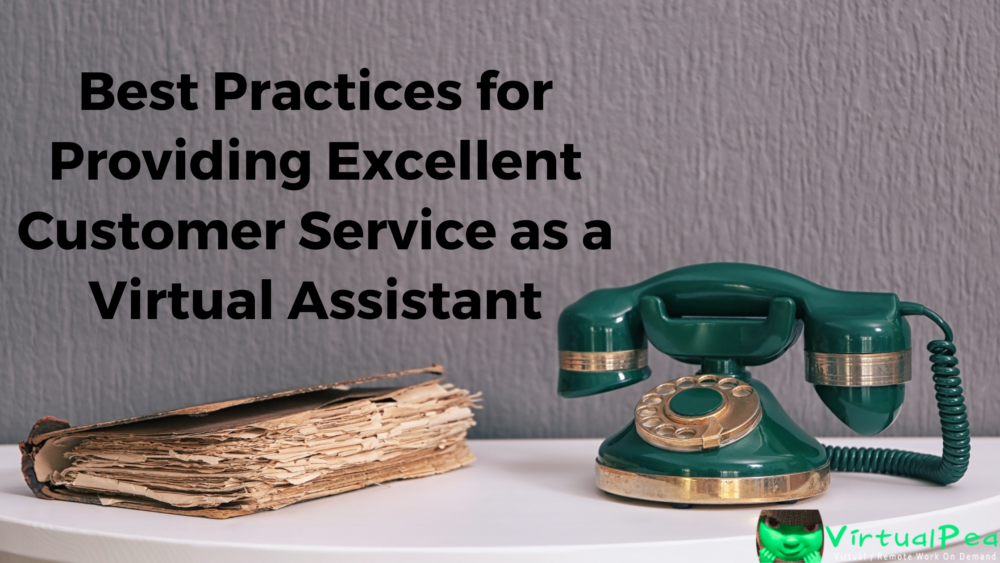
As a virtual assistant, providing excellent customer service is crucial for building strong client relationships and fostering satisfaction. Despite working remotely, you can still deliver top-notch service by implementing effective strategies. In this article, we will explore the best practices for providing exceptional customer service as a virtual assistant. From effective communication and responsiveness to proactive problem-solving and professionalism, these practices will help you exceed client expectations and thrive in your role.
1. Master Communication Skills
Clear and efficient communication is the foundation of excellent customer service. Maintain regular and open lines of communication with your clients, utilizing channels like email, instant messaging, or video calls. Actively listen to their needs, ask clarifying questions, and provide timely and concise responses. Ensure that your messages are professional, courteous, and free from any misunderstandings. Effective communication builds trust and fosters a positive working relationship with your clients.
2. Be Responsive and Timely
Timeliness is crucial in a remote working environment. Respond promptly to client inquiries, emails, or requests, even if it is just to acknowledge receipt. Set clear expectations regarding response times and availability, ensuring that you meet or exceed them consistently. If you are unable to address a client’s request immediately, communicate a timeline for when they can expect a resolution. Being responsive and timely demonstrates your commitment to client satisfaction.

3. Proactively Solve Problems
Anticipate and proactively address potential issues before they become problems for your clients. Actively seek ways to streamline processes, improve efficiency, and enhance the overall client experience. Offer suggestions and solutions when you identify areas for improvement. By taking a proactive approach, you demonstrate your commitment to providing exceptional service and alleviating potential frustrations.
4. Maintain Professionalism
Maintaining professionalism is vital as a virtual assistant. Present yourself in a polished and professional manner, both in written and verbal communications. Adhere to deadlines and deliverables, honoring your commitments. Respect client confidentiality and handle sensitive information securely. When facing challenges or conflicts, maintain a calm and professional demeanor, striving for effective resolution. Professionalism instills confidence in your clients and reinforces your commitment to delivering high-quality service.
5. Seek Feedback and Continuously Improve
Regularly seek feedback from your clients to understand their satisfaction levels and identify areas for improvement. Encourage open and honest communication, welcoming suggestions or critiques. Act on feedback by making necessary adjustments and incorporating lessons learned into your future interactions. Continuous improvement demonstrates your dedication to delivering exceptional customer service and strengthens client relationships.
Delivering excellent customer service as a virtual assistant is achievable by implementing these best practices. Mastering communication skills, being responsive, proactively solving problems, maintaining professionalism, and seeking feedback will help you exceed client expectations and establish long-lasting relationships. By providing exceptional customer service, you enhance client satisfaction, foster loyalty, and differentiate yourself in the virtual assistant industry.
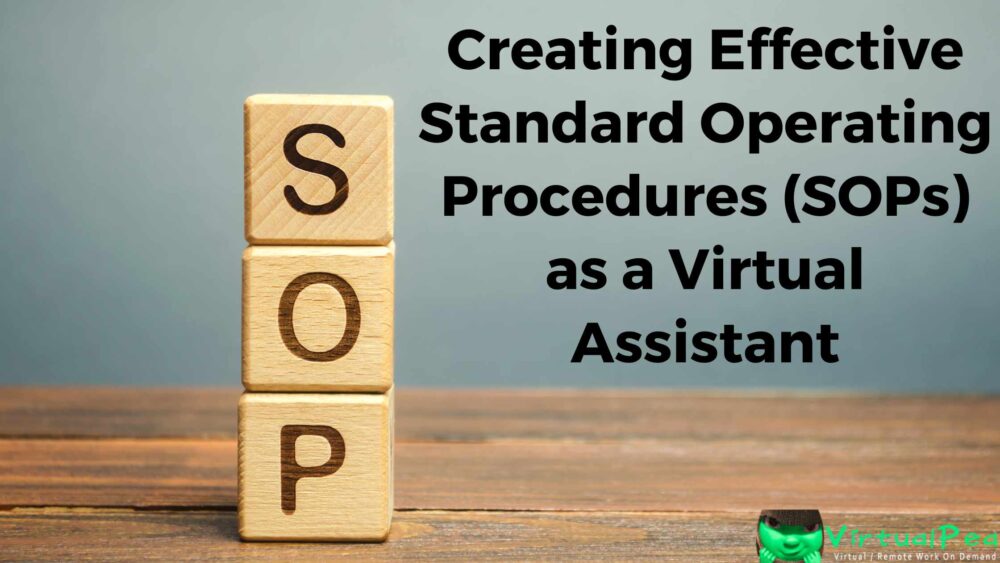
As a virtual assistant, creating effective Standard Operating Procedures (SOPs) is key to streamlining workflows, ensuring consistency, and maximizing efficiency. SOPs provide a documented framework for performing tasks and processes, which is crucial for maintaining quality standards and enabling seamless collaboration with clients and team members. In this article, we will explore the importance of creating effective SOPs as a virtual assistant and provide valuable tips for their implementation.
1. Understand the Purpose and Benefits of SOPs
Before diving into creating SOPs, it’s important to understand their purpose and benefits. SOPs serve as a guidebook for performing tasks consistently and efficiently. They ensure that processes are documented and can be easily replicated, reducing the chances of errors or misunderstandings. SOPs also contribute to effective remote team management by providing a clear framework for collaboration and ensuring everyone is on the same page.
2. Identify Key Processes and Tasks
Start by identifying the key processes and tasks that you regularly perform as a virtual assistant. These could include client onboarding, email management, social media scheduling, or any other recurring tasks. Break down each process into smaller steps to ensure comprehensive documentation. By focusing on the most critical and frequently performed tasks, you can create SOPs that have the greatest impact on your efficiency.

3. Document Processes Step-by-Step
Once you’ve identified the key processes, it’s time to document them step-by-step. Clearly outline each action, including any relevant details, tools, or resources required. Use a consistent format and language to ensure clarity and ease of understanding. Consider including screenshots or video tutorials to provide visual aids and make the SOPs more accessible.
4. Review and Refine SOPs
Regularly review and refine your SOPs to ensure they remain up to date and relevant. As you gain experience and encounter new challenges, you may discover opportunities for improvement or identify additional steps to enhance efficiency. Encourage feedback from clients or team members to gather insights and refine your SOPs accordingly. By continuously improving your SOPs, you can optimize your workflows and adapt to changing circumstances.
5. Train and Share SOPs
Effectively implementing SOPs involves training and sharing them with your team or clients. Take the time to explain the purpose and details of the SOPs to ensure everyone understands the processes and expectations. Provide clear instructions on how to access and utilize the SOPs, whether through a shared document repository or a project management tool. Regularly communicate the importance of following SOPs and encourage feedback for further improvement.
Creating effective Standard Operating Procedures (SOPs) is vital for virtual assistants to enhance efficiency, ensure consistency, and streamline workflows. By understanding the purpose and benefits of SOPs, identifying key processes, documenting them step-by-step, reviewing and refining regularly, and training and sharing SOPs with your team, you can establish a framework for efficient remote team management. Embrace SOPs as a valuable tool to optimize your performance as a virtual assistant and deliver exceptional results for your clients.

Marketing your virtual assistant services effectively is essential for attracting clients and building a successful freelance business. With the increasing demand for remote work, it’s crucial to utilize online marketing strategies to stand out in a competitive landscape. In this article, we will explore effective ways to market your virtual assistant services online. From leveraging social media platforms to implementing content marketing tactics, these strategies will help you promote your services, attract clients, and establish a strong online presence.
1. Define Your Target Audience
Before you start marketing your virtual assistant services, it’s essential to define your target audience. Identify the specific types of clients you want to work with, such as entrepreneurs, small business owners, or professionals in a particular industry. Understanding your target audience will help you tailor your marketing efforts to resonate with their needs and preferences.
2. Build a Professional Website
A professional website is the cornerstone of your online presence. Create a user-friendly website that showcases your virtual assistant services, highlights your skills and experience, and includes testimonials or case studies from satisfied clients. Optimize your website with relevant keywords and ensure it loads quickly on both desktop and mobile devices. Include a clear call-to-action (CTA) to encourage potential clients to reach out or request more information.

3. Utilize Social Media Platforms
Social media platforms provide an excellent opportunity to promote your virtual assistant services and engage with potential clients. Identify the platforms where your target audience is most active and create compelling profiles. Regularly share valuable content related to your services, industry insights, and tips that demonstrate your expertise. Engage with your audience by responding to comments and messages promptly. Consider running targeted ads or sponsored posts to reach a wider audience.
4. Leverage Content Marketing
Content marketing is a powerful strategy for showcasing your expertise and attracting clients. Create valuable and informative content through blog posts, articles, or video tutorials that address common challenges faced by your target audience. Optimize your content with relevant keywords to improve search engine visibility. Share your content on your website, social media platforms, and relevant online communities to establish yourself as an authority in the virtual assistant industry.
5. Network and Collaborate
Networking and collaborating with other professionals in your industry can help expand your reach and attract clients. Join online communities, professional organizations, and virtual assistant forums where you can connect with potential clients and build relationships with peers. Offer your expertise through guest blogging or participating in webinars or podcasts. Collaborate with complementary service providers to offer bundled services or cross-promote each other’s businesses.
Marketing your virtual assistant services effectively online is crucial for attracting clients and growing your freelance business. By defining your target audience, building a professional website, utilizing social media platforms, leveraging content marketing, and networking with peers, you can establish a strong online presence and showcase your expertise.
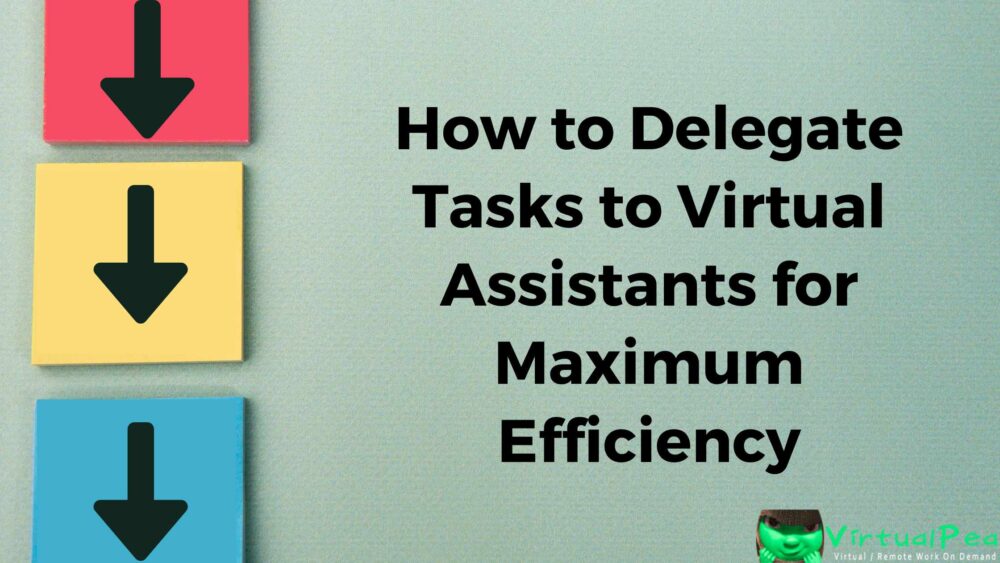
Delegating tasks to virtual assistants is a powerful way to increase efficiency and productivity in your business. As a virtual assistant manager, it’s important to understand how to effectively delegate tasks to ensure they are completed efficiently and to free up time for more critical responsibilities. In this article, we will explore strategies for delegating tasks to virtual assistants for maximum efficiency.
1. Clearly Communicate Expectations
When delegating tasks to virtual assistants, it’s crucial to communicate expectations clearly. Clearly define the desired outcome and provide specific instructions on how the task should be completed. Outline any deadlines, quality standards, or important details that need to be considered. Effective communication helps virtual assistants understand what is expected of them, reducing the chances of misunderstandings or delays.
2. Choose the Right Virtual Assistant
Assigning tasks to the right virtual assistant is essential for efficient delegation. Consider each virtual assistant’s skills, experience, and strengths when deciding which tasks to delegate. Match their expertise with the nature of the task to ensure it is completed with the highest level of proficiency. By delegating tasks to virtual assistants who possess the necessary skills, you can increase efficiency and optimize task completion.

3. Provide Clear Instructions and Resources
Along with clear expectations, provide virtual assistants with detailed instructions and necessary resources to complete the task. This may include access to specific files, tools, or software, as well as any relevant guidelines or templates. Clear instructions empower virtual assistants to perform their duties effectively and independently, saving time and minimizing the need for additional clarification.
4. Establish a Collaborative Workflow
Create a collaborative workflow that promotes effective communication and feedback between virtual assistants and yourself. Set up regular check-ins or progress meetings to discuss ongoing tasks, answer questions, and provide feedback. Foster an environment where virtual assistants feel comfortable seeking clarification or sharing any challenges they may encounter. Regular communication helps ensure tasks are on track and provides opportunities for improvement and learning.
5. Trust and Empower Your Virtual Assistants
Trust is a fundamental aspect of efficient task delegation. Empower your virtual assistants by giving them autonomy and the authority to make decisions within their assigned tasks. Encourage them to suggest improvements or share innovative ideas. By trusting and empowering your virtual assistants, you foster a sense of ownership and accountability, which leads to increased efficiency and productivity.
Delegating tasks to virtual assistants can significantly enhance the efficiency of your business. By clearly communicating expectations, choosing the right virtual assistant, providing clear instructions and resources, establishing a collaborative workflow, and trusting and empowering your virtual assistants, you can maximize the efficiency of task delegation. Embrace these strategies to streamline your business operations, free up time for critical responsibilities, and create a productive and collaborative environment with your virtual assistant team.
